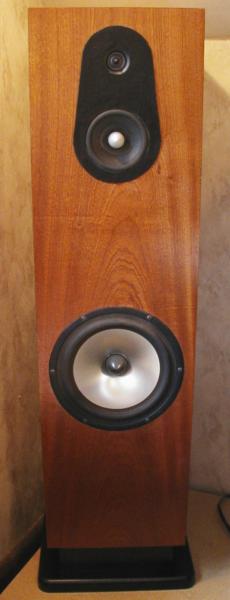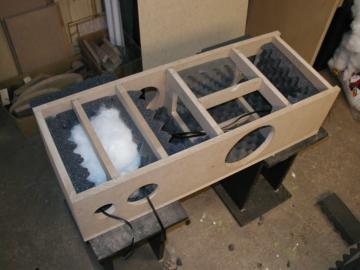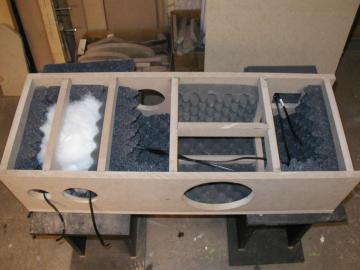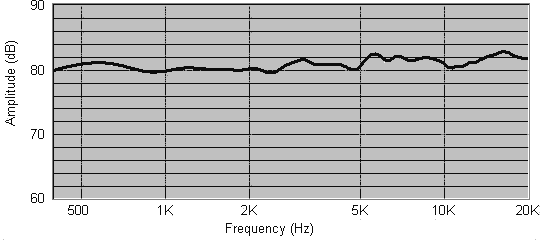

IntroductionThe Alpheus MkII is a floorstanding 3 way speaker using the Seas L22RN4X/P 8" aluminum woofer, Peerless HDS Exclusive 830881 4" Nomex midrange and Vifa XT19TD00-04 3/4" ring radiator tweeter. This design replaces an earlier version of this speaker which used the Seas L12 aluminum midrange driver. The original version was designed around faulty tweeters with an over detailed midrange that could get harsh and fatiguing at times. The new version sounds much smoother and cleaner with very little listening fatigue at all. Their most notable trait is their high level of "clarity" while remaining smooth. They aren't extremely detailed but they aren't muddy either. Overall they are a fairly neutral speaker. The bass output extends below 30Hz and the sensitivity is a bit on the low side at 84dB. The original Alpheus design was my first attempt at a three way speaker and the new MkII version is quite an improvement. Keep in mind that my speakers are listed in chronological order on the project page so my comments reflect only this design and others that have been built prior to this. With that said I would have to say that this design is one of the best sounding projects I've built so far and more details can be found below.DriversVifa XT19TD00-04 3/4" dual concentric ring radiator fabric dome tweeter This superb 3/4" tweeter features a patented dual concentric diaphragm and a unique wave guide center plug which provides excellent on and off axis response. The smaller voice coil diameter takes the dual concentric concept even further, providing even greater high frequency extension and off-axis performance. Unshielded variety; recommended for high crossover points.
Cabinet Design
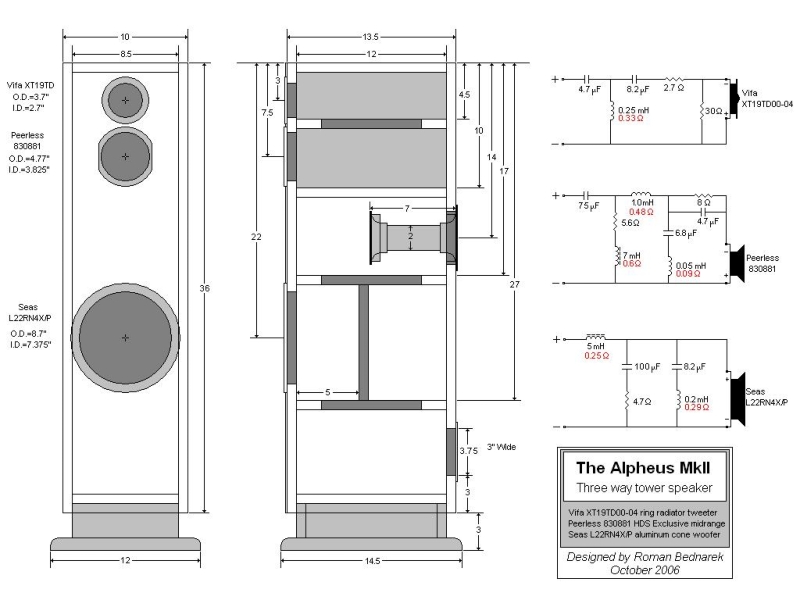 Crossover DesignThe crossover for this version of the Alpheus design uses a topology that is nearly identical to the original. I used 2nd order slopes (12 dB/octave) between the woofer and midrange and 4th order slopes (24 dB/octave) between the midrange and tweeter. The crossover points are around 350 Hz and 2.6 kHz. The woofer low pass filter includes a notch filter to tame the resonance peak of the L22 aluminum woofer along with a standard 2nd order electrical filter (with an added resistor to lower the Q and slope of the filter). This notch filter lowered the L22's cone resonance to a level that is over 50dB down relative to the overall speaker response level. The midrange filter also incorporates a notch filter. This notch filter was initially intended to take care of the 9kHz resonance peak that the L12 had but also works well with the 830881 since it also has a peak in that region but with a lower Q. The high pass section of the midrange filter uses a standard 2nd order electrical filter with an added resistor to lower the Q and slope of the filter. The low pass section of the midrange filter also uses a 2nd order electrical filter. The 8 ohm resistor is to attenuate the midrange slightly and the parallel 4.7 uF capacitor provides a slight boost in the 1-2 kHz range. The tweeter uses a standard 3rd order electrical filter with an L-pad resistor attenuation configuration. The tweeter slope is actually a bit steeper than the midrange slope which provides better phase alignment with a flat baffle configuration (because the acoustic center of the midrange is further back the tweeter needs to be "delayed" a bit for better phase integration).The woofer filter employs a 5 mH steel core inductor for lower DCR. It also uses a 100 uF capacitor and I chose to use an 80 uF electrolytic in parallel with a 20 uF metallized poly cap to obtain this value. I figured that since this is a parallel element it was less critical (low ESR not as important) and figured that the electrolytic would cause negligible degradation on the overall performance. This cut the cost quite a bit and also saved a lot of space on the crossover board. The midrange filter uses a large 75 uF capacitor as a series element. I chose to go with a metallized poly capacitor for this value instead of an electrolytic. This cap is more critical than the woofer cap because it is in series with the network (where ESR might alter the response) and is connected to the midrange which covers frequencies that the ear is very sensitive to. For this version I went with some steel core inductors for the 7 mH value because I already had them and didn't feel like spending the extra money (and space) for air core inductors. I am pretty sure that this inductor will not reach saturation levels because it is in series with a large resistor and the power levels drawn by the midrange are much lower than those drawn by a larger bass driver. If you choose to use an air core inductor for this value I would recommend reducing the series resistor to compensate for the added DCR of the coil. With the high costs of copper I think the wisest thing to do is to go with the 18 gauge 7 mH laminated steel core inductors that I chose or any other less expensive alternative. I used 25W wire wound resistors for the 5.6 ohm and 4.7 ohm values. The rest of the resistors are 10W non-inductive resistors and the crossover shown below includes both Dayton and Eagle (for the 2.7 ohm value) resistors. The 8 ohm midrange resistor is actually two 16 ohm 10W non-inductive resistors placed in parallel. The 0.2 mH and 0.25 mH inductors are 20 gauge air core and the 0.05 mH and 1.0 mH inductors are 18 gauge air core. I used a mixture of Dayton and Solen Metallized polypropylene capacitors because I feel they offer a good level of performance for the price. 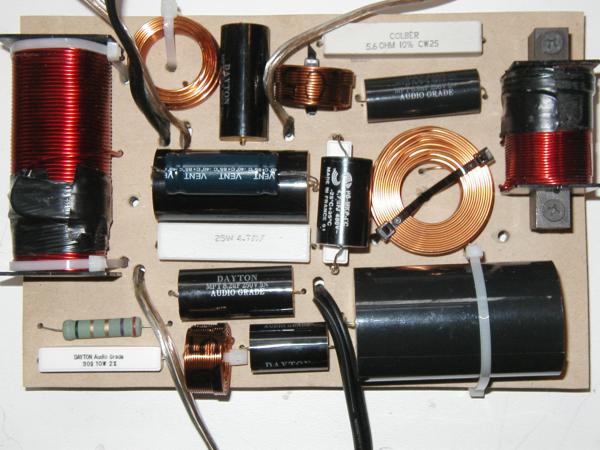 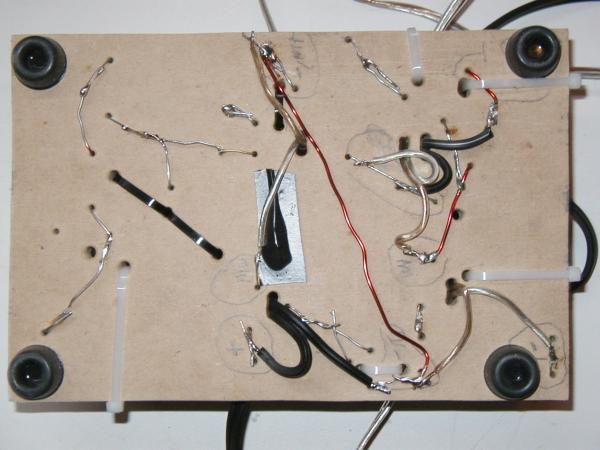 I managed to fit everything on a 6"x9" board including 6 different inductors which I tried to arrange in a manner that minimizes interference between them. As you can see, the large 75 uF poly cap takes up a good chunk of the crossover board as well as the 5 mH steel core inductor. I have separate connections for the bass filter and the midrange/tweeter filters that connect to dual pairs of binding posts and allows me to bi-amp the speakers between the bass and mid/tweeter sections. Performance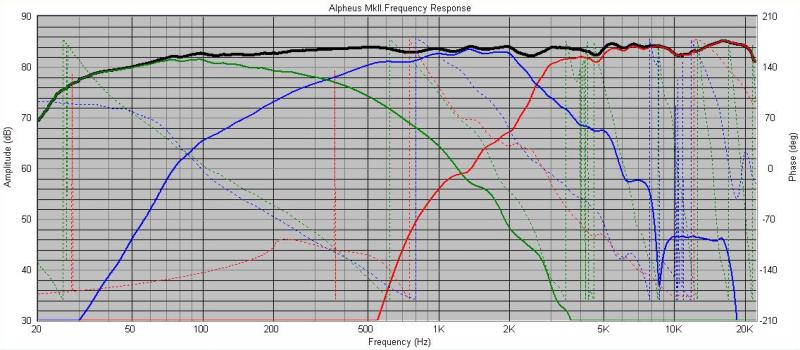 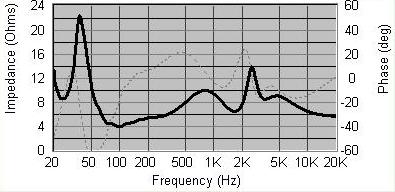
The plot above allows you to view the frequency response of the design at different listening angles. These measurements were taken from about 4 feet away and the phase alignment between the drivers isn't quite as good at this close of a listening distance which is why this set of measurements indicates a slightly lower output in the midrange region. These speakers perform quite well off axis but I've found that I tend to prefer listening with the speakers toed inward slightly so that I am on axis with the tweeter. Vertically the response remains quite good within the +/-10 degree window that I measured. After listening to these speakers I've found that they sound quite good off axis and much better than they did before with the Seas L12 midrange driver. Listening ImpressionsI'll start by saying that these are the best sounding speakers (based on my preferences) that I have built so far. Just remember that in the past few years I've been saying that a lot because my designs seem to be advancing but I'll note that Asterion/Astorius RS combination was my previous favorite three way design until I completed this design. There really isn't much that the Alpheus MkII speakers do wrong. They are probably one of the most neutral sounding speakers I've designed but don't sound over analytical. They have a certain clarity to their presentation that gives them a combination of detail and smoothness at the same time. The imaging and soundstage characteristics are quite good. The imaging is pretty focused due to the clarity of their sound but the soundstage is still fairly deep and spacious. I'll next discuss the performance based on the individual drivers' contribution.Prior to replacing my faulty XT19 tweeters I felt that they were harsh and overly detailed. With the new set of XT19 tweeters my impression has changed dramatically. The XT19 tweeter is very smooth sounding but doesn't lack crispness or clarity. It has just the right amount of sparkle at the top end and sometimes has a somewhat three dimension presentation. It is definitely not a dull sounding tweeter but also doesn't seem to add anything extra to the sound of instruments playing in its range. The dispersion is pretty good and I think this helps with some of the qualities I described above. I would have to say that the XT19 is one of my favorite tweeters and at its price is probably a better value than my favorite Hiquphon OW1 tweeter. The only issue with this tweeter is that it is best to cross it above 2.5kHz with 4th order slopes but this is the sacrifice that must be made to get the superior dispersion of a smaller tweeter. The Peerless HDS Exclusive 830881 midrange driver works great as a replacement for the Seas L12. I tend to prefer the sound of paper type cone drivers over metal cone drivers and this 830881 seems like a good compromise because it is a paper like (Nomex) driver that is on the stiff side which I think give it the best properties of both paper and metal cone drivers. The properties of this driver seem to give it a very clear sound that isn't excessively detailed or harsh. It really sounds great in the range where I am using it and yields a very flat frequency response. I think the midrange driver plays a big part in defining the sound of a three way speaker and this one compliments the other drivers well to provide a fairly neutral midrange sound. The Seas L22 is a very nice sounding woofer. I did a comparison a while back between the L22 and the Dayton RS225 that can be found under my Astorius project page. I found the L22 to have a cleaner, more detailed sound than the RS225 and most woofers in general. This driver provides some of the cleanest ported bass I've heard. The bass has more "texture" to it and rarely sounds muddy or muffled. I sometimes wonder if it is distortion that is making the bass sound so detailed but then think that even if it is distortion, it sounds pretty good to me. I used a lower port tuning frequency of 27Hz for this design which allows the bass to go deep with a gradual roll off until you get to the port tuning point. I think that this tuning helps match the speakers to the room better because there is often a lot of room gain in this region where most speakers would have peaks. The certainly play deep and clean and have no indications of major resonances in my smaller listening room. If you found that the bass is too thin or too strong due to the amount of baffle step compensation that I've implemented or just your personal preference then you can bi-amp this speaker which would allow you to adjust the level of the L22 independently. If you choose to do this to boost or cut the bass then the only thing you have to watch out for is that you don't overcompensate and compromise the neutrality of the midrange because the L22 contributes up to about 500 Hz. I think there is a reason why this speaker has become my new favorite... It uses all of my favorite driver types for each frequency range. In general I prefer fabric dome tweeters over metal dome tweeters but don't have much experience with ribbon tweeters. Fabric dome tweeters just seem to have more sparkle and life to my ears. I often like to generalize the differences between the fabric and metal dome tweeters I've used and I've found that the differences are most noticeable when comparing something like a ride cymbal or tambourine. The metal domes always seem to have a cleaner, clearer sounding fundamental tone while the fabric tweeters seem to emphasize the resulting shimmer and sparkle to a greater degree. I like paper or paper like midrange drivers because they seem to offer the best compromise between detail and smoothness. I think that this is a key to making a speaker that is enjoyable to listen to that has the right level of clarity without becoming harsh sounding. For the bass driver I've found that metal cones work very well and sound very good. I think a stiff cone is important when a driver is reproducing bass frequencies and this could attribute to why the L22 sounds so clean. Even if distortion is present in a woofer the operating range is so low in frequency that the distortion doesn't become harsh sounding but may actually enhance the clarity of the bass and lower midrange. Since I suspected that this would be my new favorite speaker design I decided to compare them side by side with my previous favorite design, the Asterion. The Asterions definitely have more of a character to their sound than the Alpheus MkII design especially in the midrange region. As I've said before, the Asterion midrange is a bit on the warm side and can almost sound a bit resonant at times. The Alpheus MkII has a clearer midrange presentation with more emphasis on the mid to upper midrange and overall has a more neutral sound. However, the midrange character of the Asterion design gives them a very pleasing, musical sound that makes them sound very smooth and enhances the soundstage depth. The soundstage is deeper and more spacious with the Asterions but the imaging suffers slightly as a result. The clarity of the Alpheus MkII design results in more focused imaging and just enough soundstage depth. In general the Alpheus MkII seem to do a better job of preserving the source signal and relaying it to your ears in an accurate manner. In the treble region the Asterions have a bit more air and sparkle at the top end which gives them a bit more life and depth in that region. I would categorize this as being the major difference between these tweeters. From what I have seen on other sites the XT19 is actually a lower distortion tweeter than the OW1 so I suspect the XT19 might actually have a more accurate presentation. The Alpheus MkII is the clear winner in the bass region. I had known that the XT18 woofer in the Asterion wasn't the best performer below 200 Hz according to distortion measurements. The L22 simply sounds cleaner, less muffled and more detailed than the XT18 and it can handle more power. So I think that pretty much sums up why I have a new favorite speaker design. If I were to try to generalize my previous comparison to discuss the differences between the Alpheus MkII and the Asterion/Astorius (or Astorius RS) combo I think a lot of the same things discussed above would apply. However, the Asterion/Astorius combination has less of an issue with the warm midrange but still has a lot of the same midrange character as the Asterion and just as spacious of a soundstage. In general I would still have to say that the Alpheus MkII is probably a more neutral sounding speaker while the Asterion/Astorius combination is a more musical sounding speaker. There is a review which compares the Alpheus with the Daedalus (RS 3 way) and the Asterion here. I'll get back to some more comments about the sound characteristics of the Alpheus MkII speaker. One thing that surprised me about these speakers is they sound great at higher listening levels. Now keep in mind that 85-90 dB is a high listening level for me but at this volume level I don't notice much listening fatigue at all and the presentation is quite clear and full. Due to their clarity I find myself listening at higher levels than usual because they aren't harsh at all. The combination of midrange clarity and a non-fatiguing sound seems a bit rare based on the designs I've worked on in the past. I've mentioned in the past that some of my speaker projects sound best with well recorded material and don't do very well with poor recordings while other speakers sound smooth with a poor recording but lack the clarity to reproduce all of the details in a clean recording. The amazing thing about the Alpheus MkII speakers is they sound great with any type of recording. I'll admit that they really shine with a clean jazz recording but what surprises me is that they sound smooth with harsher rock music without sacrificing any detail or clarity. I often use Rush or Counting Crows CDs to judge whether a speaker is harsh or not and these speakers sound great with both of them. I've heard those recordings sound smooth and non-fatiguing before but it was usually on a speaker that had a recessed midrange and sacrificed detail and clarity to get that smooth sound. These speakers let you hear all of the details in the music without fatigue. One funny thing that I noticed about these speakers while I was tweaking the crossover is that they seem to make every recording sound different to a degree greater than I was used to. Some speakers just have a certain character to them that can be noticeable with various different recordings while these speakers seem to drastically change in character from CD to CD. I can't really explain it but I do know that it made it very difficult to tune the crossovers without overcompensating in one region where the particular recording might have a peak or a dip only to realize that the next recording needs the opposite adjustment. So to summarize, the Alpheus MkII speaker sounds great with just about any type of recording and sound really good with a nice clean recording. The final thing I'm going to add are some comments that my friend made while auditioning the speakers over the past few weeks. He owns a pair of B&W Nautilus 802 speakers and has been comparing them to my Alpheus MkII speakers. Now keep in mind that he has different equipment and the speakers are in a different (larger) room so some of the differences could be attributed to other factors. The comment that surprised me the most was when he said that the Alpheus MkII speakers are probably more neutral than his B&W Nautilus 802 speakers. He also said that the midrange character of the Alpheus MkII design had a lot of similarities to his speakers which was a great compliment. One difference that he noted was that the upper midrange/lower treble region seemed to be stronger with his speakers which would sometimes make them a bit harsher at times. He said that the metal dome tweeter in his speakers had a different character than the XT19 but liked smooth, clear sound of the XT19 tweeters. Bass clarity was one category that he felt his speakers always excelled in but found the L22 to sound even clearer and more detailed than his speakers although he considered the fact that the room has a strong influence on this region. He's listened to just about every speaker I've designed and proclaimed that the Alpheus MkII speakers are the best sounding speakers I've made so far. I haven't done a recent calculation on the expected cost of a pair of Alpheus MkII speakers and since copper prices have recently gone up (inductors) I suspect these might cost a bit more. I need to update my previous projects to reflect this as well. If I had to guess I would say that these speakers should cost around $800 a pair including cabinets but that's just a very rough guess. The cabinets shown below are covered with sapele veneer. ReviewsThis section includes reviews of the Alpheus MkII design who have either heard my pair or have built a pair of their own. So far I am the only person that I know of who has built this design so I only have one review written by my friend who I mentioned above. He has heard every one of my designs and always offers great feedback which helps me optimize the crossover. His words are more accurate than the paragraph above where I try to translate his comments which came during various stages of the crossover design process. Without further delay here's his review.... Following the upgrades to the midrange driver, the crossover, and replacement of defective tweeters, the Alpheus has blossomed into a smooth-sounding and very musical speaker. Previously the Alpheus had demonstrated a generous detailed bass response without the usual mid-bass boom so frequently heard, but the midrange was dull and the highs were harsh to the point that listening fatigue would set in within minutes for an on-axis listener. In its reincarnation the Alpheus has lost none of its previous excellence in the bass region, the treble harshness is completely gone, and the midrange has come to life! Although my audition of the Alpheus took place in a relatively small room with one speaker in a corner and the other with its back against a wall, the soundstage was relatively wide and deep, with very good imaging. Since the bass would certainly be severely rolled off in the small room if the speakers were pulled away from the walls this was not done; the soundstage and imaging was so good that it wasn't necessary. I've requested a chance to listen to them in a larger room (like at my place, hint!), but I've heard nothing to suggest that the Alpheus would not sound even better in a medium-sized room and away from the walls; my relatively large room offers plenty of natural bass reinforcement, and the Alpheus can handle quite a bit more power than we could stand in the small room. Many smaller speakers don't handle power very well and while that ability is an important criteria of mine, Roman seldom listens at high power levels. That's changed in the case of the Alpheus though: last time we listened, it was obvious to me from the previous volume setting that Roman likes the Alpheus loud too. The biggest negative criticism that I have of the Alpheus is also one of its good points: the treble is pretty mellow compared to my B&W 802N's. I miss some of the treble detail that I'm accustomed to at home, but not always: the B&W's are so reveiling that some recordings are unbearably harsh. The Alpheus's are so smooth and etch-free that such recordings are much more listenable. Of course on a really good recording the treble clarity of the B&W's is one of the things that makes them great, and I miss that when I compare them to the Alpheus even though I don't think that they are leaving out any material. One of the B&W's strong points is in the midrange, where they're both musical and analytical at the same time. The new Alpheus surprised me in that regard: while they don't sound much like my B&W's in the midrange, they're extremely clear and musical in their own way. They have a more natural midrange sound than my beloved B&Ws. All in all, the Alpheus is an excellent speaker. The bass is remarkably smooth and extended for their size. I consider them to be worthy of comparison with all but the most outrageous of the "high-end" speakers that I've heard, including my B&W's. They're very listenable speakers, and I think that Roman will be hanging on to them for the forseeable future. It's amazing how far they've come; at one time (before the upgrades) they were relegated to the storage area, for sale with no takers. They've now risen from the ashes, like the proverbial Pheonix. 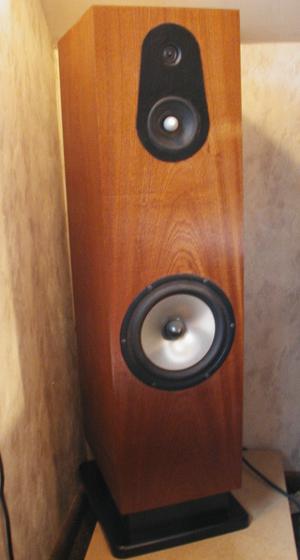 |
